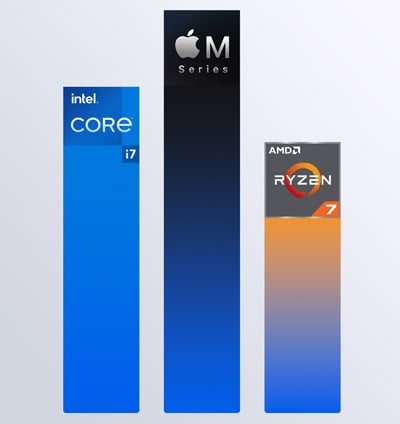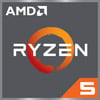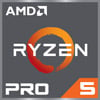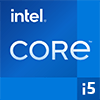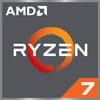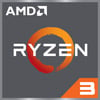
AMD Ryzen 5 3600 vs Intel Core i5-10400
Last updated:
CPU comparison with benchmarks
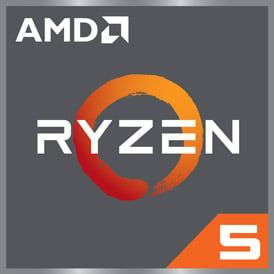
|
 |
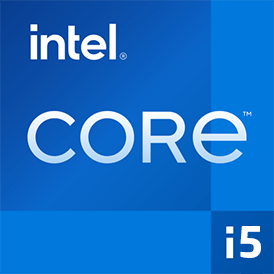
|
| AMD Ryzen 5 3600 | Intel Core i5-10400 | |
CPU comparisonIn this CPU comparison, we compare the AMD Ryzen 5 3600 and the Intel Core i5-10400 and use benchmarks to check which processor is faster.
We compare the AMD Ryzen 5 3600 6 core processor released in Q3/2019 with the Intel Core i5-10400 which has 6 CPU cores and was introduced in Q2/2020. |
||
| AMD Ryzen 5 (84) | Family | Intel Core i5 (331) |
| AMD Ryzen 3000 (15) | CPU group | Intel Core i 10000 (43) |
| 3 | Generation | 10 |
| Matisse (Zen 2) | Architecture | Comet Lake S |
| Desktop / Server | Segment | Desktop / Server |
| AMD Ryzen 5 2600 | Predecessor | Intel Core i5-9400 |
| -- | Successor | Intel Core i5-11400 |
|
|
||
CPU Cores and Base FrequencyThe AMD Ryzen 5 3600 is a 6 core processor with a clock frequency of 3.60 GHz (4.20 GHz). The processor can compute 12 threads at the same time. The Intel Core i5-10400 clocks with 2.90 GHz (4.30 GHz), has 6 CPU cores and can calculate 12 threads in parallel. |
||
| AMD Ryzen 5 3600 | Characteristic | Intel Core i5-10400 |
| 6 | Cores | 6 |
| 12 | Threads | 12 |
| normal | Core architecture | normal |
| Yes | Hyperthreading | Yes |
| Yes | Overclocking ? | No |
| 3.60 GHz | Frequency | 2.90 GHz |
| 4.20 GHz | Turbo Frequency (1 Core) | 4.30 GHz |
| 4.00 GHz | Turbo Frequency (All Cores) | 4.00 GHz |
Internal GraphicsGraphics (iGPU) integrated into the processor not only enable image output without having to rely on a dedicated graphics solution, but can also efficiently accelerate video playback. |
||
| no iGPU | GPU | Intel UHD Graphics 630 |
| GPU frequency | 0.35 GHz | |
| -- | GPU (Turbo) | 1.20 GHz |
| -- | GPU Generation | 9.5 |
| Technology | 14 nm | |
| Max. displays | 3 | |
| -- | Compute units | 24 |
| -- | Shader | 192 |
| No | Hardware Raytracing | No |
| No | Frame Generation | No |
| -- | Max. GPU Memory | 64 GB |
| -- | DirectX Version | 12 |
Hardware codec supportA photo or video codec that is accelerated in hardware can greatly accelerate the working speed of a processor and extend the battery life of notebooks or smartphones when playing videos. |
||
| no iGPU | GPU | Intel UHD Graphics 630 |
| No | Codec h265 / HEVC (8 bit) | Decode / Encode |
| No | Codec h265 / HEVC (10 bit) | Decode / Encode |
| No | Codec h264 | Decode / Encode |
| No | Codec VP9 | Decode / Encode |
| No | Codec VP8 | Decode / Encode |
| No | Codec AV1 | No |
| No | Codec AVC | Decode / Encode |
| No | Codec VC-1 | Decode |
| No | Codec JPEG | Decode / Encode |
Memory & PCIeUp to 128 GB of memory in a maximum of 2 memory channels is supported by the AMD Ryzen 5 3600, while the Intel Core i5-10400 supports a maximum of 128 GB of memory with a maximum memory bandwidth of 42.7 GB/s enabled. |
||
| AMD Ryzen 5 3600 | Characteristic | Intel Core i5-10400 |
| DDR4-3200 | Memory | DDR4-2666 |
| 128 GB | Max. Memory | 128 GB |
| 2 (Dual Channel) | Memory channels | 2 (Dual Channel) |
| 51.2 GB/s | Max. Bandwidth | 42.7 GB/s |
| Yes | ECC | No |
| -- | L2 Cache | -- |
| 32.00 MB | L3 Cache | 12.00 MB |
| 4.0 | PCIe version | 3.0 |
| 20 | PCIe lanes | 16 |
| 39.4 GB/s | PCIe Bandwidth | 15.8 GB/s |
Thermal ManagementThe AMD Ryzen 5 3600 has a TDP of 65 W. The TDP of the Intel Core i5-10400 is 65 W. System integrators use the TDP of the processor as a guide when dimensioning the cooling solution. |
||
| AMD Ryzen 5 3600 | Characteristic | Intel Core i5-10400 |
| 65 W | TDP (PL1 / PBP) | 65 W |
| -- | TDP (PL2) | -- |
| -- | TDP up | -- |
| -- | TDP down | -- |
| 95 °C | Tjunction max. | 100 °C |
Technical detailsThe AMD Ryzen 5 3600 has 32.00 MB cache and is manufactured in 7 nm. The cache of Intel Core i5-10400 is at 12.00 MB. The processor is manufactured in 14 nm. |
||
| AMD Ryzen 5 3600 | Characteristic | Intel Core i5-10400 |
| 7 nm | Technology | 14 nm |
| Chiplet | Chip design | Monolithic |
| x86-64 (64 bit) | Instruction set (ISA) | x86-64 (64 bit) |
| SSE4a, SSE4.1, SSE4.2, AVX2, FMA3 | ISA extensions | SSE4.1, SSE4.2, AVX2 |
| AM4 (PGA 1331) | Socket | LGA 1200 |
| AMD-V, SVM | Virtualization | VT-x, VT-x EPT, VT-d |
| Yes | AES-NI | Yes |
| Windows 10, Windows 11, Linux | Operating systems | Windows 10, Windows 11, Linux |
| Q3/2019 | Release date | Q2/2020 |
| 185 $ | Release price | 182 $ |
| show more data | show more data | |
Rate these processors
Average performance in benchmarks
⌀ Single core performance in 7 CPU benchmarks
⌀ Multi core performance in 9 CPU benchmarks
Cinebench 2024 (Single-Core)
The Cinebench 2024 benchmark is based on the Redshift rendering engine, which is also used in Maxon's 3D program Cinema 4D. The benchmark runs are each 10 minutes long to test whether the processor is limited by its heat generation.
|
|
AMD Ryzen 5 3600
6C 12T @ 4.20 GHz |
||
|
|
Intel Core i5-10400
6C 12T @ 4.30 GHz |
||
Cinebench 2024 (Multi-Core)
The Multi-Core test of the Cinebench 2024 benchmark uses all cpu cores to render using the Redshift rendering engine, which is also used in Maxons Cinema 4D. The benchmark run is 10 minutes long to test whether the processor is limited by its heat generation.
|
|
AMD Ryzen 5 3600
6C 12T @ 4.20 GHz |
||
|
|
Intel Core i5-10400
6C 12T @ 4.30 GHz |
||
Cinebench R23 (Single-Core)
Cinebench R23 is the successor of Cinebench R20 and is also based on the Cinema 4 Suite. Cinema 4 is a worldwide used software to create 3D forms. The single-core test only uses one CPU core, the amount of cores or hyperthreading ability doesn't count.
|
|
AMD Ryzen 5 3600
6C 12T @ 4.20 GHz |
||
|
|
Intel Core i5-10400
6C 12T @ 4.30 GHz |
||
Cinebench R23 (Multi-Core)
Cinebench R23 is the successor of Cinebench R20 and is also based on the Cinema 4 Suite. Cinema 4 is a worldwide used software to create 3D forms. The multi-core test involves all CPU cores and taks a big advantage of hyperthreading.
|
|
AMD Ryzen 5 3600
6C 12T @ 4.00 GHz |
||
|
|
Intel Core i5-10400
6C 12T @ 4.00 GHz |
||
Geekbench 5, 64bit (Single-Core)
Geekbench 5 is a cross plattform benchmark that heavily uses the systems memory. A fast memory will push the result a lot. The single-core test only uses one CPU core, the amount of cores or hyperthreading ability doesn't count.
|
|
AMD Ryzen 5 3600
6C 12T @ 4.20 GHz |
||
|
|
Intel Core i5-10400
6C 12T @ 4.30 GHz |
||
Geekbench 5, 64bit (Multi-Core)
Geekbench 5 is a cross plattform benchmark that heavily uses the systems memory. A fast memory will push the result a lot. The multi-core test involves all CPU cores and taks a big advantage of hyperthreading.
|
|
AMD Ryzen 5 3600
6C 12T @ 4.00 GHz |
||
|
|
Intel Core i5-10400
6C 12T @ 4.00 GHz |
||
Geekbench 6 (Single-Core)
Geekbench 6 is a benchmark for modern computers, notebooks and smartphones. What is new is an optimized utilization of newer CPU architectures, e.g. based on the big.LITTLE concept and combining CPU cores of different sizes. The single-core benchmark only evaluates the performance of the fastest CPU core, the number of CPU cores in a processor is irrelevant here.
|
|
AMD Ryzen 5 3600
6C 12T @ 4.20 GHz |
||
|
|
Intel Core i5-10400
6C 12T @ 4.30 GHz |
||
Geekbench 6 (Multi-Core)
Geekbench 6 is a benchmark for modern computers, notebooks and smartphones. What is new is an optimized utilization of newer CPU architectures, e.g. based on the big.LITTLE concept and combining CPU cores of different sizes. The multi-core benchmark evaluates the performance of all of the processor's CPU cores. Virtual thread improvements such as AMD SMT or Intel's Hyper-Threading have a positive impact on the benchmark result.
|
|
AMD Ryzen 5 3600
6C 12T @ 4.00 GHz |
||
|
|
Intel Core i5-10400
6C 12T @ 4.00 GHz |
||
Cinebench R20 (Single-Core)
Cinebench R20 is the successor of Cinebench R15 and is also based on the Cinema 4 Suite. Cinema 4 is a worldwide used software to create 3D forms. The single-core test only uses one CPU core, the amount of cores or hyperthreading ability doesn't count.
|
|
AMD Ryzen 5 3600
6C 12T @ 4.20 GHz |
||
|
|
Intel Core i5-10400
6C 12T @ 4.30 GHz |
||
Cinebench R20 (Multi-Core)
Cinebench R20 is the successor of Cinebench R15 and is also based on the Cinema 4 Suite. Cinema 4 is a worldwide used software to create 3D forms. The multi-core test involves all CPU cores and taks a big advantage of hyperthreading.
|
|
AMD Ryzen 5 3600
6C 12T @ 4.00 GHz |
||
|
|
Intel Core i5-10400
6C 12T @ 4.00 GHz |
||
Blender 3.1 Benchmark
In the Blender Benchmark 3.1, the scenes "monster", "junkshop" and "classroom" are rendered and the time required by the system is measured. In our benchmark we test the CPU and not the graphics card. Blender 3.1 was presented as a standalone version in March 2022.
|
|
AMD Ryzen 5 3600
6C 12T @ 4.00 GHz |
||
|
|
Intel Core i5-10400
6C 12T @ 4.00 GHz |
||
Estimated results for PassMark CPU Mark
Some of the CPUs listed below have been benchmarked by CPU-monkey. However the majority of CPUs have not been tested and the results have been estimated by a CPU-monkey’s secret proprietary formula. As such they do not accurately reflect the actual Passmark CPU mark values and are not endorsed by PassMark Software Pty Ltd.
|
|
AMD Ryzen 5 3600
6C 12T @ 4.00 GHz |
||
|
|
Intel Core i5-10400
6C 12T @ 4.00 GHz |
||
CPU-Z Benchmark 17 (Single-Core)
The CPU-Z benchmark measures a processor's performance by measuring the time it takes the system to complete all benchmark calculations. The faster the benchmark is completed, the higher the score.
|
|
AMD Ryzen 5 3600
6C 12T @ 4.00 GHz |
||
|
|
Intel Core i5-10400
6C 12T @ 4.00 GHz |
||
CPU-Z Benchmark 17 (Multi-Core)
The CPU-Z benchmark measures a processor's performance by measuring the time it takes the system to complete all benchmark calculations. The faster the benchmark is completed, the higher the score.
|
|
AMD Ryzen 5 3600
6C 12T @ 3.60 GHz |
||
|
|
Intel Core i5-10400
6C 12T @ 2.90 GHz |
||
Cinebench R15 (Single-Core)
Cinebench R15 is the successor of Cinebench 11.5 and is also based on the Cinema 4 Suite. Cinema 4 is a worldwide used software to create 3D forms. The single-core test only uses one CPU core, the amount of cores or hyperthreading ability doesn't count.
|
|
AMD Ryzen 5 3600
6C 12T @ 4.20 GHz |
||
|
|
Intel Core i5-10400
6C 12T @ 4.30 GHz |
||
Cinebench R15 (Multi-Core)
Cinebench R15 is the successor of Cinebench 11.5 and is also based on the Cinema 4 Suite. Cinema 4 is a worldwide used software to create 3D forms. The multi-core test involves all CPU cores and taks a big advantage of hyperthreading.
|
|
AMD Ryzen 5 3600
6C 12T @ 4.00 GHz |
||
|
|
Intel Core i5-10400
6C 12T @ 4.00 GHz |
||
iGPU - FP32 Performance (Single-precision GFLOPS)
The theoretical computing performance of the internal graphics unit of the processor with simple accuracy (32 bit) in GFLOPS. GFLOPS indicates how many billion floating point operations the iGPU can perform per second.
|
|
AMD Ryzen 5 3600
@ 0.00 GHz |
||
|
|
Intel Core i5-10400
Intel UHD Graphics 630 @ 1.20 GHz |
||
Blender 2.81 (bmw27)
Blender is a free 3D graphics software for rendering (creating) 3D bodies, which can also be textured and animated in the software. The Blender benchmark creates predefined scenes and measures the time (s) required for the entire scene. The shorter the time required, the better. We selected bmw27 as the benchmark scene.
|
|
AMD Ryzen 5 3600
6C 12T @ 4.00 GHz |
||
|
|
Intel Core i5-10400
6C 12T @ 4.00 GHz |
||
CPU performance per watt (efficiency)
Efficiency of the processor under full load in the Cinebench R23 (multi-core) benchmark. The benchmark result is divided by the average energy required (CPU package power in watts). The higher the value, the more efficient the CPU is under full load.
|
|
AMD Ryzen 5 3600
9,150 CB R23 MC @ 87 W |
||
|
|
Intel Core i5-10400
2.90 GHz |
||
Devices using this processor |
|
| AMD Ryzen 5 3600 | Intel Core i5-10400 |
| One Gaming PC Ryzen 5 3600 Lenono IdeaCentre T540-15AMA G HP Pavilion Gaming TG01-0201ng schwarz (9HP03EA#ABD) |
Unknown |
News and articles for the AMD Ryzen 5 3600 and the Intel Core i5-10400
Comparison of the two processors
The two 6-core processors AMD Ryzen 5 3600 and Intel Core i5-10400 serve the lower mid-range segment and both cost around 160-180 euros. With their 6 cores and 12 threads, the processors are well suited for modern PC games.The clock frequency of the AMD Ryzen 5 3600 is 3.6 GHz. In turbo mode, the processor can increase its clock frequency up to 4.0 GHz (all cores) or 4.2 GHz (single core mode). The Intel Core i5-10400 has similar clock frequencies. Although it has a lower base frequency of only 2.9 GHz, it can also increase it to 4.0 GHz (load on all cores) or 4.3 GHz (single core load). The advantage of the AMD ryzen 5 3600 is its free multiplier, which makes it very easy to overclock. Intel, on the other hand, blocks the Intel Core i5-10400 for overclocking.
For this, the Intel Core i5-10400 has an internal graphics card, the Intel UHD Graphics 630. This has 24 execution units and 192 shaders, but is far too slow for modern games. Nevertheless, the graphics card can connect 4K monitors and also play videos smoothly. The new and free video codec "AV1" is not yet accelerated by the graphics card in hardware.
Both desktop processors can connect up to 128 GB of RAM, whereby the AMD Ryzen 5 3600 is approved for DDR4-3200, while the Intel Core i5-10400 can officially only handle DDR4-2933. Via the Intel XMP or AMD D.O.C.P. However, the overclocking profile of the main memory can also be achieved very easily with higher clock frequencies, so that both processors actually always manage at least DDR4-3600.
AMD has the AMD Ryzen 5 3600 manufactured at TSMC in a 7 nm process, while Intel manufactures the Intel Core i5-10400 itself in 14 nm. Although both processors have a TDP of 65 watts, the AMD processor is more efficient due to the finer manufacturing structure.
Popular comparisons containing this CPUs
back to index




